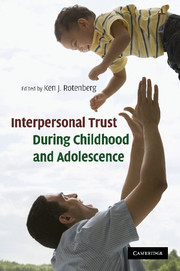Book contents
- Frontmatter
- Contents
- List of figures
- List of tables
- List of contributors
- Section I Conceptual foundations and issues
- Section II Childhood
- 5 Young children's trust in what other people say
- 6 Social relation and mutual influence analyses of children's interpersonal trust
- 7 Siblings and trust
- 8 The role of promises for children's trustworthiness and honesty
- 9 Liar liar! Pants on fire: Detecting the trustworthiness of children's statements
- Section III Adolescence and early adulthood
- Index
- References
9 - Liar liar! Pants on fire: Detecting the trustworthiness of children's statements
Published online by Cambridge University Press: 04 August 2010
- Frontmatter
- Contents
- List of figures
- List of tables
- List of contributors
- Section I Conceptual foundations and issues
- Section II Childhood
- 5 Young children's trust in what other people say
- 6 Social relation and mutual influence analyses of children's interpersonal trust
- 7 Siblings and trust
- 8 The role of promises for children's trustworthiness and honesty
- 9 Liar liar! Pants on fire: Detecting the trustworthiness of children's statements
- Section III Adolescence and early adulthood
- Index
- References
Summary
Interpersonal trust is essential to our social relations and is vital for maintaining positive interpersonal relations, both in terms of friendship formation and maintenance and in terms of conventions of day-to-day communications (Grice, 1980; Rotenberg, 1991; Rotter, 1980). Honesty is an integral part of trustworthiness. According to Rotenberg and colleagues' conceptualization of trustworthiness, honesty is one of three bases of trust (Rotenberg, Boulton, and Fox, 2005; Rotenberg, Fox, Green, Ruderman, Slater, Stevens, and Carlo, 2005; Rotenberg, MacDonald, and King, 2004). According to this framework, there are three fundamental bases of trustworthiness that include honesty (which is the focus of this chapter), reliability, and emotional trust (see Chapter 2 for further details). Others' perceptions of one's honesty are also an important aspect of trustworthiness, as they can affect the assessment of one's trustworthiness and have social consequences. Individuals hold cognitive representations of the extent to which they trust another (i.e., belief that another is telling the truth). Thus, an adult may believe that a child is honest. However, there is also the actual behavior of the child, which is their dispositional trustworthiness. A child's dispositional trustworthiness is reflected in their behavior to tell the truth and keep promises. Thus, there is a dyadic relationship between both trust beliefs and the trustworthiness revealed by the child's behavior. A dyadic partner holds trust beliefs that may match (or mismatch) the trustworthiness of another.
- Type
- Chapter
- Information
- Interpersonal Trust during Childhood and Adolescence , pp. 177 - 200Publisher: Cambridge University PressPrint publication year: 2010



